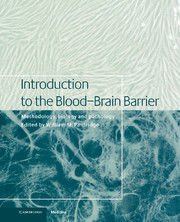Book contents
- Frontmatter
- Contents
- List of contributors
- 1 Blood–brain barrier methodology and biology
- Part I Methodology
- Part II Transport biology
- Part III General aspects of CNS transport
- Part IV Signal transduction/biochemical aspects
- 31 Regulation of brain endothelial cell tight junction permeability
- 32 Chemotherapy and chemosensitization
- 33 Lipid composition of brain microvessels
- 34 Brain microvessel antigens
- 35 Molecular dissection of tight junctions: occludin and ZO-1
- 36 Phosphatidylinositol pathways
- 37 Nitric oxide and endothelin at the blood–brain barrier
- 38 Role of intracellular calcium in regulation of brain endothelial permeability
- 39 Cytokines and the blood-brain barrier
- 40 Blood–brain barrier and monoamines, revisited
- Part V Pathophysiology in disease states
- Index
31 - Regulation of brain endothelial cell tight junction permeability
from Part IV - Signal transduction/biochemical aspects
Published online by Cambridge University Press: 10 December 2009
- Frontmatter
- Contents
- List of contributors
- 1 Blood–brain barrier methodology and biology
- Part I Methodology
- Part II Transport biology
- Part III General aspects of CNS transport
- Part IV Signal transduction/biochemical aspects
- 31 Regulation of brain endothelial cell tight junction permeability
- 32 Chemotherapy and chemosensitization
- 33 Lipid composition of brain microvessels
- 34 Brain microvessel antigens
- 35 Molecular dissection of tight junctions: occludin and ZO-1
- 36 Phosphatidylinositol pathways
- 37 Nitric oxide and endothelin at the blood–brain barrier
- 38 Role of intracellular calcium in regulation of brain endothelial permeability
- 39 Cytokines and the blood-brain barrier
- 40 Blood–brain barrier and monoamines, revisited
- Part V Pathophysiology in disease states
- Index
Summary
Introduction
The blood-brain barrier (BBB) forms when endothelial cells (ECs) that make up brain capillaries adopt the dual features of a low rate of fluid phase endocytosis and high resistance tight junctions. Although the BBB has been studied for more than 100 years and is recognized as being important in establishing an appropriate extracellular environment for cells in the brain, there are a surprising number of fundamental uncertainties concerning the formation and regulation of this barrier. One question concerns the time of formation of the BBB, with estimates ranging, for rodent, from embryonic day 15 or so to postnatal day 14 (Mollgard and Saunders, 1986; Risau and Wolberg, 1990). Further, it is not clear whether the barrier forms all at once – becomes impermeable to proteins and ions simultaneously, or only gradually, with, perhaps, ionic impermeability being achieved after macromolecular impermeability. Another question concerns the induction of BBB formation. It is thought that ECs in brain become different from those in the periphery when exposed to factors found only in the brain environment (Stewart and Wiley, 1981). These factors, however, are still unknown. Until recently, it was thought by most investigators that astrocytes were the source of such factors (Janzer and Raff, 1987), perhaps the only such source, but this has recently been called into question (Holash and Stewart, 1993).
- Type
- Chapter
- Information
- Introduction to the Blood-Brain BarrierMethodology, Biology and Pathology, pp. 293 - 300Publisher: Cambridge University PressPrint publication year: 1998
- 2
- Cited by



